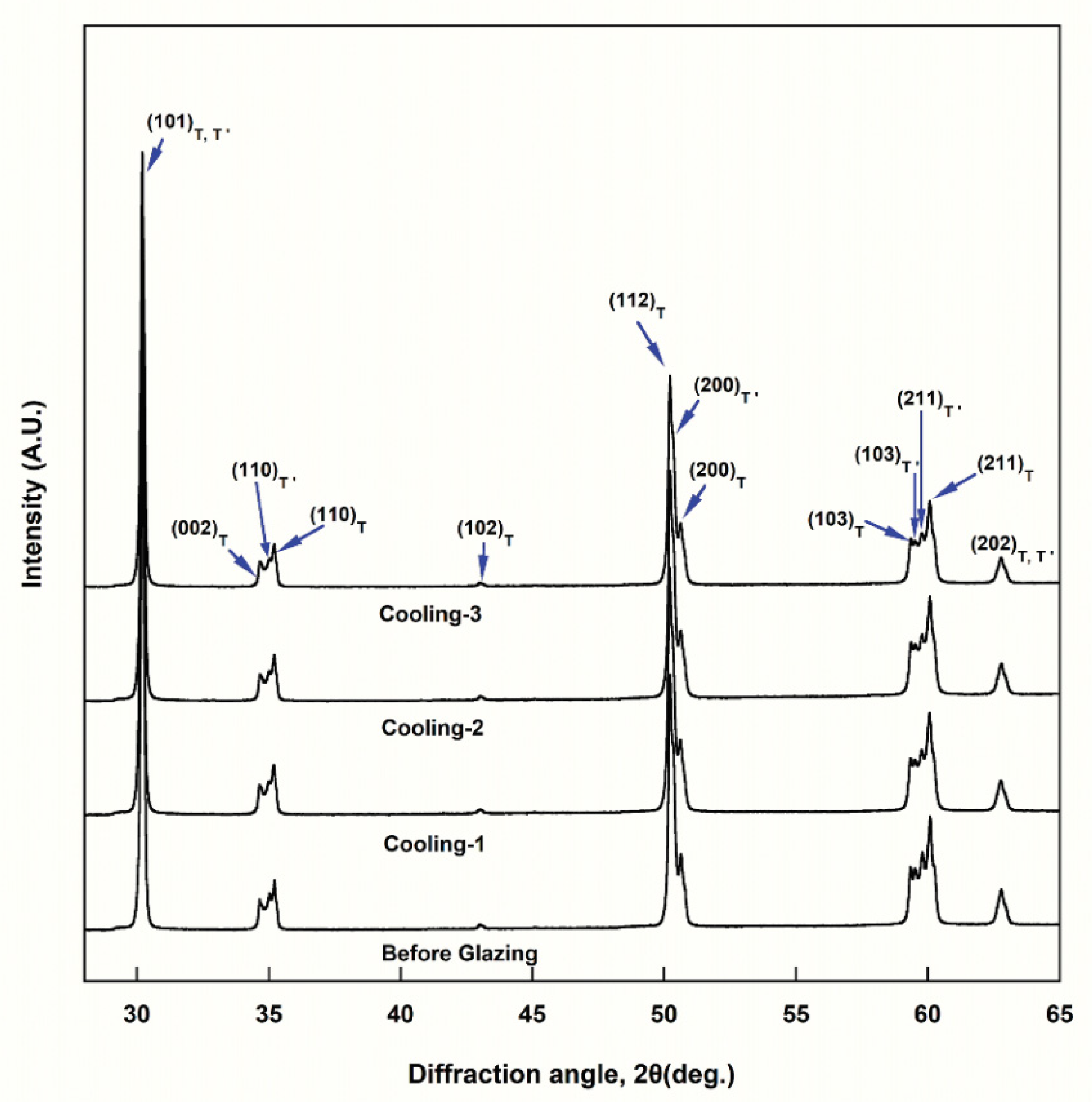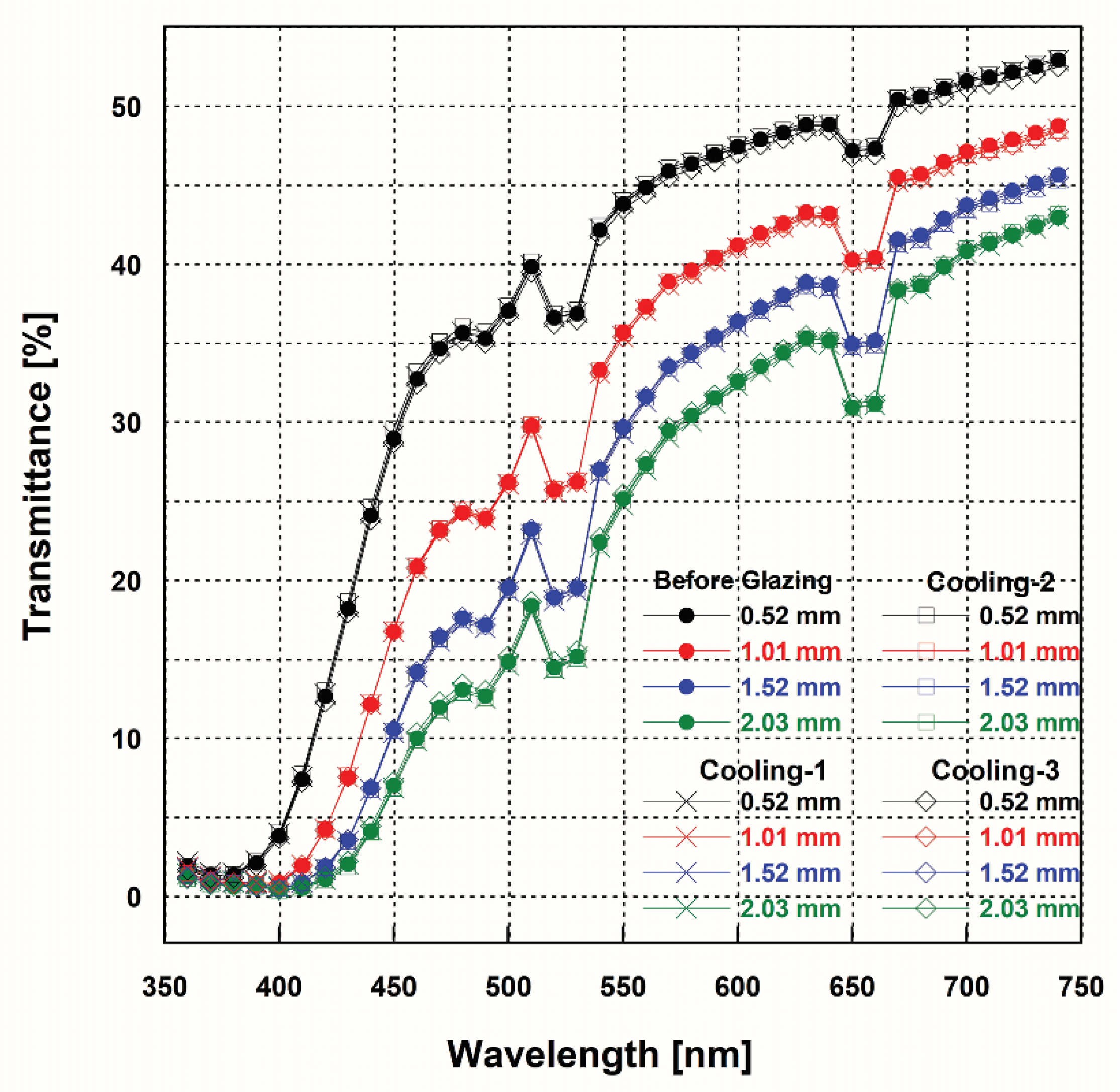Effect of Cooling Rate on Mechanical Properties, Translucency, Opalescence, and Light Transmission Properties of Monolithic 4Y-TZP during Glazing
Abstract
1. Introduction
2. Materials and Methods
2.1. Preparation of Specimens
2.2. Glazing Heat Treatment
2.3. Hardness Test
2.4. FE-SEM Observation
2.5. XRD Analysis
2.6. Flexural Strength Measurement
2.7. Optical Properties Evaluation
2.8. Statistical Analysis
3. Results
3.1. Hardness
3.2. FE-SEM Analysis
3.3. XRD Analysis
3.4. Flexural Strength
3.5. Spectral Transmittance and Average Transmittance (AT)
3.6. Translucency Parameter (TP)
3.7. Opalescence Parameter (OP)
4. Discussion
5. Conclusions
Author Contributions
Funding
Institutional Review Board Statement
Informed Consent Statement
Data Availability Statement
Conflicts of Interest
References
- Gautam, C.; Joyner, J.; Gautam, A.; Rao, J.; Vajtai, R. Zirconia based dental ceramics: Structure, mechanical properties, biocompatibility and applications. Dalton Trans. 2016, 45, 19194215. [Google Scholar] [CrossRef]
- Denry, I.; Kelly, J.R. State of the art of zirconia for dental applications. Dent. Mater. 2008, 24, 299–307. [Google Scholar] [CrossRef]
- Zhang, Y.; Lawn, B.R. Evaluating dental zirconia. Dent. Mater. 2019, 35, 15–23. [Google Scholar] [CrossRef]
- Benetti, P.; Kelly, J.R.; Della Bona, A. Analysis of thermal distributions in veneered zirconia and metal restorations during firing. Dent. Mater. 2013, 29, 1166–1172. [Google Scholar] [CrossRef]
- Baldassarri, M.; Stappert, C.F.; Wolff, M.S.; Thompson, V.P.; Zhang, Y. Residual stresses in porcelain-veneered zirconia prostheses. Dent. Mater. 2012, 28, 873–879. [Google Scholar] [CrossRef]
- Tholey, M.J.; Swain, M.V.; Thiel, N. Thermal gradients and residual stresses in veneered Y-TZP frameworks. Dent. Mater. 2011, 27, 1102–1110. [Google Scholar] [CrossRef]
- Baldi, A.; Comba, A.; Ferrero, G.; Italia, E.; Tempesta, R.M.; Paolone, G.; Mazzoni, A.; Breschi, L.; Scotti, N. External gap progression after cyclic fatigue of adhesive overlays and crowns made with high translucency zirconia or lithium silicate. J. Esthet. Restor. Dent. 2022, 34, 557–564. [Google Scholar] [CrossRef]
- Hannink, R.H.J.; Kelly, P.M.; Muddle, B.C. Transformation toughening in zirconia-containing ceramics. J. Am. Ceram. Soc. 2000, 83, 461–487. [Google Scholar] [CrossRef]
- Stawarczyk, B.; Ozcan, M.; Hallmann, L.; Ender, A.; Mehl, A.; Hammerlet, C.H.F. The effect of zirconia sintering temperature on flexural strength, grain size, and contrast ratio. Clin. Oral Investig. 2013, 17, 269–274. [Google Scholar] [CrossRef]
- Ueda, K.; Guth, J.F.; Erdelt, K.; Stimmelmayr, M.; Kappert, H.; Beuer, F. Light transmittance by a multi-coloured zirconia material. Dent. Mater. J. 2015, 34, 310–314. [Google Scholar] [CrossRef]
- Kim, H.K. Optical and mechanical properties of highly translucent dental zirconia. Materials 2020, 13, 3395. [Google Scholar] [CrossRef]
- Cekic-Nagas, I.; Egilmez, F.; Ergun, G.; Kaya, B.M. Light transmittance of zirconia as a function of thickness and microhardness of resin cements under different thickness of zirconia. Med. Oral Patol. Oral Cir. Bucal. 2013, 18, e212–e218. [Google Scholar] [CrossRef]
- Kim, M.J.; Ahn, J.S.; Kim, J.H.; Kim, H.Y.; Kim, W.C. Effects of the sintering conditions of dental zirconia ceramics on the grain size and translucency. J. Adv. Prosthodont. 2013, 5, 161–166. [Google Scholar] [CrossRef]
- Jansen, J.U.; Lümkemann, N.; Letz, I.; Pfefferle, R.; Sener, B.; Ing, D.; Stawarczyk, B. Impact of high-speed sintering on translucency, phase content, grain sizes, and flexural strength of 3Y-TZP and 4Y-TZP zirconia materials. J. Prosthet. Dent. 2019, 122, 396–403. [Google Scholar] [CrossRef]
- O’Brien, W.J. Dental Materials and Their Selection, 4th ed.; Quintessence Publishing Co, Inc.: Hanover Park, IL, USA, 2008; pp. 29, 31. [Google Scholar]
- Kim, H.K. Effect of a rapid-cooling protocol on the optical and mechanical properties of dental monolithic zirconia containing 3–5 mol% Y2O3. Materials 2020, 13, 1923. [Google Scholar] [CrossRef]
- Cho, M.S.; Yu, B.; Lee, Y.K. Opalescence of all-ceramic core and veneer materials. Dent. Mater. 2009, 25, 695–702. [Google Scholar] [CrossRef]
- Lee, Y.K.; Yu, B. Measurement of opalescence of tooth enamel. J. Dent. 2007, 35, 690–694. [Google Scholar] [CrossRef]
- Zena, R. Evolution of dental ceramics. Compend. Contin. Educ. Dent. 2001, 22, 12–14. [Google Scholar]
- Kumchai, H.; Juntavee, P.; Sun, A.F.; Nathanson, D. Effect of glazing on flexural strength of full-contour zirconia. Int. J. Dent. 2018, 8, 1–5. [Google Scholar] [CrossRef]
- Manawi, M.; Ozcan, M.; Madina, M.; Cura, C.; Valandro, L.F. Impact of surface finishes on the flexural strength and fracture toughness of In-Ceram zirconia. Gen. Dent. 2012, 60, 138–142. [Google Scholar]
- Nam, M.G.; Park, M.G. Changes in the flexural strength of translucent zirconia due to glazing and low-temperature degradation. J. Prosthet. Dent. 2018, 120, 969.e1–969.e6. [Google Scholar] [CrossRef] [PubMed]
- Yener, E.S.; Ozcan, M.; Kazazoglu, E. The effect of glazing on the biaxial flexural strength of different zirconia core materials. Acta Odontol. Latinoam. 2011, 24, 133–140. [Google Scholar] [PubMed]
- Manziuc, M.M.; Gasparik, C.; Burde, A.V.; Colosi, H.A.; Negucioiu, M.; Dudea, D. Effect of glazing on translucency color and surface roughness of monolithic zirconia materials. J. Esthet. Restor. Dent. 2019, 31, 478–485. [Google Scholar] [CrossRef] [PubMed]
- Ozturk, C.; Celik, E. Influence of heating rate on the flexural strength of monolithic zirconia. J. Adv. Prosthodont. 2019, 11, 202–208. [Google Scholar] [CrossRef]
- Shiraishi, T.; Wood, D.J.; Shinozaki, N.; van Noort, R. Optical properties of base dentine ceramics for all-ceramic restorations. Dent. Mater. 2011, 27, 165–172. [Google Scholar] [CrossRef] [PubMed]
- Lee, Y.K.; Lu, H.; Powers, J.M. Measurement of opalescence of resin composites. Dent. Mater. 2005, 21, 1068–1074. [Google Scholar] [CrossRef] [PubMed]
- Wang, F.; Takahashi, H.; Iwasaki, N. Translucency of dental ceramics with different thicknesses. J. Prosthet. Dent. 2013, 110, 14–20. [Google Scholar] [CrossRef]
- Trunec, M. Effect of grain size on mechanical properties of 3Y-TZP ceramics. Ceramics 2008, 52, 165–171. [Google Scholar]
- Li, Q.L.; Jiang, Y.Y.; Wei, Y.R.; Swain, M.V.; Yao, M.F.; Li, D.S.; Wei, T.; Jian, Y.T.; Zhao, K.; Wang, X.D. The influence of yttria content on the microstructure, phase stability and mechanical properties of dental zirconia. Ceram. Int. 2021, 48, 5361–5368. [Google Scholar] [CrossRef]
- Stawarczyk, B.; Emslander, A.; Roos, M.; Sener, B.; Noack, F.; Keul, C. Zirconia ceramics, their contrast ratio and grain size depending on sintering parameters. Dent. Mater. J. 2014, 33, 591–598. [Google Scholar] [CrossRef]
- Weibull, W. A statistical distribution function of wide applicability. ASME J. Appl. Mech. 1951, 18, 293–297. [Google Scholar] [CrossRef]
- Cho, M.H.; Seol, H.J. Effect of cooling rate during glazing on the mechanical and optical properties of monolithic zirconia with 3 mol% yttria content. Materials 2021, 14, 7474. [Google Scholar] [CrossRef] [PubMed]
- Cotic, J.; Jevnikar, P.; Kocjan, A.; Kosmac, T. Complexity of the relationships between the sintering-temperature-dependent grain size, airborne-particle abrasion, ageing and strength of 3Y-TZP ceramics. Dent. Mater. 2016, 32, 510–518. [Google Scholar] [CrossRef] [PubMed]
- Shiraishi, T.; Watanabe, I. Thickness dependence of light transmittance, translucency and opalescence of a ceria-stabilized zirconia/alumina nanocomposite for dental applications. Dent. Mater. 2016, 32, 660–667. [Google Scholar] [CrossRef] [PubMed]
- Cekic-Nagas, I.; Egilmez, F.; Ergun, G. Comparison of light transmittance in different thicknesses of zirconia under various light curing units. J. Adv. Prosthodont. 2012, 4, 93–96. [Google Scholar] [CrossRef][Green Version]
- Tilley, R.J.D. Colour and the Optical Properties of Materials, 2nd ed.; John Willey & Sons, Ltd.: Hoboken, NJ, USA, 2011; pp. 33–36. [Google Scholar]
- Elsaka, S.E. Optical and mechanical properties of newly developed monolithic multilayer zirconia. J. Prosthodont. 2019, 28, e279–e284. [Google Scholar] [CrossRef]



| Pre- Drying (min) | Heat Rate (°C/min) | Start Temp. (°C) | Final Temp. (°C) | Hold Time (min) | Vacuum Level (cm/HG) | Start Vacuum (°C) | Vacuum Release(°C) |
|---|---|---|---|---|---|---|---|
| 5 | 65 | 600 | 850 | 1 | 72 | 600 | 850 |
| Cooling Rate | Cooling-1 | Cooling-2 | Cooling-3 |
|---|---|---|---|
| °C/min | >250 | 62.5 | 35.7 |
| Condition | Firing chamber moves immediately to upper end position | Firing chamber moves gradually to upper end position | Firing chamber remains closed |
| Cooling time | 0 min (no cooling time) | 4 min (manufacturer’s suggestion) | 7 min (extended cooling time) |
| Code | Mean Hardness±SD (HV) | Mean Grain Size ±SD (μm) | Mean Flexural Strength ±SD (MPa) | Characteristic Strength, σ0 (MPa) (95% Confidence Interval) | Weibull Modulus, m (95% Confidence Interval) |
|---|---|---|---|---|---|
| Before Glazing | 1401.06b (4.89) | 0.474a (0.18) | 849.58a (118.77) | 900.03 (860.14–941.77) | 8.34 (6.31–11.01) |
| Cooling-1 | 1396.77a (5.79) | 0.479a (0.15) | 855.33a (139.30) | 913.72 (866.77–963.21) | 7.17 (5.41–9.50) |
| Cooling-2 | 1400.23b (4.07) | 0.474a (0.15) | 805.47a (121.73) | 857.59 (814.60–902.84) | 7.37 (5.61–9.69) |
| Cooling-3 | 1400.54b (4.43) | 0.467a (0.14) | 838.41a (119.83) | 888.71 (848.41–930.92) | 8.14 (6.18–10.72) |
| Code | Before Glazing | Cooling-1 | Cooling-2 | Cooling-3 |
|---|---|---|---|---|
| 0.52 mm | 36.10Dab (0.24) | 36.14Dab (0.20) | 36.32Db (0.22) | 35.76Da (0.22) |
| 1.01 mm | 29.28Ca (0.24) | 29.16Ca (0.48) | 29.20Ca (0.24) | 29.11Ca (0.25) |
| 1.52 mm | 24.96Ba (0.13) | 24.78Ba (0.24) | 24.81Ba (0.19) | 24.90Ba (0.17) |
| 2.03 mm | 21.88Aa (0.20) | 21.74Aa (0.62) | 21.83Aa (0.40) | 22.06Aa (0.28) |
| Code | Regression Equation y = a × exp(bx) (5) | R2 | p |
|---|---|---|---|
| Before Glazing | y = 41.77exp(−0.332x) | 0.988 | <0.001 |
| Cooling-1 | y = 41.87exp(−0.338x) | 0.981 | <0.001 |
| Cooling-2 | y = 42.01exp(−0.338x) | 0.983 | <0.001 |
| Cooling-3 | y = 41.08exp(−0.321x) | 0.984 | <0.001 |
| Code | Before Glazing | Cooling-1 | Cooling-2 | Cooling-3 |
|---|---|---|---|---|
| 0.52 mm | 17.43Da (0.27) | 17.21Da (0.19) | 17.40Da (0.22) | 17.28Da (0.21) |
| 1.01 mm | 12.54Ca (0.12) | 12.51Ca (0.34) | 12.34Ca (0.15) | 12.42Ca (0.12) |
| 1.52 mm | 8.32Ba (0.12) | 8.44Ba (0.15) | 8.52Ba (0.14) | 8.35Ba (0.16) |
| 2.03 mm | 5.40Aa (0.20) | 5.65Aa (0.35) | 5.34Aa (0.16) | 5.29Aa (0.40) |
| Code | Regression Equation y = a × exp(bx) (5) | R2 | p |
|---|---|---|---|
| Before Glazing | y = 26.57exp(−0.786x) | 0.994 | <0.001 |
| Cooling-1 | y = 25.62exp(−0.748x) | 0.991 | <0.001 |
| Cooling-2 | y = 26.44exp(−0.783x) | 0.993 | <0.001 |
| Cooling-3 | y = 26.53exp(−0.792x) | 0.988 | <0.001 |
| Code | Before Glazing | Cooling-1 | Cooling-2 | Cooling-3 |
|---|---|---|---|---|
| 0.52 mm | 11.14Aa (0.22) | 10.74Aa (0.30) | 10.90Aa (0.42) | 11.32Aa (0.41) |
| 1.01 mm | 19.35Ba (0.36) | 19.07Ba (0.63) | 19.36Ba (0.67) | 19.38Ba (0.39) |
| 1.52 mm | 26.02Ca (0.71) | 25.57Ca (0.54) | 26.10Ca (0.46) | 26.22Ca (0.47) |
| 2.03 mm | 30.28Dab (0.52) | 29.71Da (1.06) | 30.70Db (1.44) | 29.77Da (0.74) |
Publisher’s Note: MDPI stays neutral with regard to jurisdictional claims in published maps and institutional affiliations. |
© 2022 by the authors. Licensee MDPI, Basel, Switzerland. This article is an open access article distributed under the terms and conditions of the Creative Commons Attribution (CC BY) license (https://creativecommons.org/licenses/by/4.0/).
Share and Cite
Jeong, J.-I.; Shin, H.-J.; Kwon, Y.H.; Seol, H.-J. Effect of Cooling Rate on Mechanical Properties, Translucency, Opalescence, and Light Transmission Properties of Monolithic 4Y-TZP during Glazing. Materials 2022, 15, 4357. https://doi.org/10.3390/ma15124357
Jeong J-I, Shin H-J, Kwon YH, Seol H-J. Effect of Cooling Rate on Mechanical Properties, Translucency, Opalescence, and Light Transmission Properties of Monolithic 4Y-TZP during Glazing. Materials. 2022; 15(12):4357. https://doi.org/10.3390/ma15124357
Chicago/Turabian StyleJeong, Ji-In, Hye-Jeong Shin, Yong Hoon Kwon, and Hyo-Joung Seol. 2022. "Effect of Cooling Rate on Mechanical Properties, Translucency, Opalescence, and Light Transmission Properties of Monolithic 4Y-TZP during Glazing" Materials 15, no. 12: 4357. https://doi.org/10.3390/ma15124357
APA StyleJeong, J.-I., Shin, H.-J., Kwon, Y. H., & Seol, H.-J. (2022). Effect of Cooling Rate on Mechanical Properties, Translucency, Opalescence, and Light Transmission Properties of Monolithic 4Y-TZP during Glazing. Materials, 15(12), 4357. https://doi.org/10.3390/ma15124357






